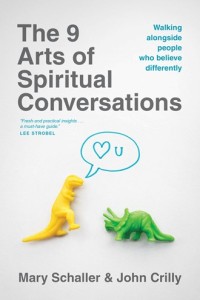 Mary Schaller and John Crilly, The 9 Arts of Spiritual Conversation: Walking Alongside People Who Believe Differently (Carol Steam, IL: Tyndale Momentum, 2016).
Mary Schaller and John Crilly, The 9 Arts of Spiritual Conversation: Walking Alongside People Who Believe Differently (Carol Steam, IL: Tyndale Momentum, 2016).
Not long ago, I was standing in line behind a man at the checkout stand of a gas station. He paid his bill and handed the cashier something, which she received with a look of befuddlement on her face. Then he turned around, handed me something, and walked out the door. He never said a word the whole time.
I looked down and realized I was holding a self-printed evangelistic tract. My first thought was, His motivation is right. That guy took the Great Commission seriously, and good for him for doing so! My second thought was, His method is wrong. All wrong, in fact. Personal evangelism is supposed to be personal, after all. This guy had passed along information to the cashier and me, but personal evangelism is not about information. It’s about relationship, both with God and with others.
Unfortunately, too many Christians view personal evangelism through an informational lens. “What should I say?” they ask. “How should I respond to this or that objection to Christianity?” “How can I turn everyday conversations into eternal conversations?” These are excellent questions, by the way. Absent relationship, however, even the best answers aren’t likely to change the minds. Psychologically, we are more likely to change our minds or believe new things when we trust the person telling us about them. And trust is a relational issue.
Studies bear out the importance of relationship in evangelism. Research commissioned by well-known evangelist Luis Palau reveals that 75 percent of people who convert to Christianity do so through relationship with a Christian family member, friend, or colleague. The Institute of American Church Growth puts the number even higher, at 90 percent. If 75–90 percent of conversions happen because of personal relationship, the conclusion is inescapable: Billy Graham is not the best evangelist to reach your neighbor. You are.
In The 9 Arts of Spiritual Conversation, Mary Schaller and John Crilly show readers how to walk “alongside people who believe differently,” so that evangelism, discipleship, and spiritual growth take place organically in an authentic relationship. Schaller and Crilly are the president and former national director, respectively, of Q Place, a parachurch ministry that trains people how to start and facilitate evangelistic small groups. They write about such small groups in chapter 12, “Starting a Q Place.” As a former small groups pastor, I like Q Place’s approach to things and encourage you to check out that ministry.
However, the majority of the book isn’t about Q Place’s ministry focus. It’s about the skills necessary to form authentic relationships in which evangelism can occur organically. Schaller and Crilly divide the “9 arts of spiritual conversation” into three broad categories. Let me outline their presentation for you:
Getting Ready
- “Noticing those around me and paying close attention to what God might be doing in their lives.”
- “Praying for those I meet in my day-to-day life and asking God to show me what he wants to do to bless them.”
- “Listening with genuine care, interest, and empathy as I interact with others without editorializing or offering my own unsolicited opinions.”
Getting Started
- “Asking questions that arise from genuine curiosity, drawing others out with great questions and seeking to understand more than to be understood.”
- “Loving others authentically because I personally know God’s love and see them with his eyes.”
- “Welcoming people by valuing their presence so they feel that they belong.”
Keeping It Going
- “Facilitating good discussions in a group setting so that every person feels honored and respected, even when they believe different than I do.”
- “Serving together, gathering people to serve and know God and each other better through service.”
- “Sharing my own story, learning others’ stories, and expressing God’s story of forgiveness through Jesus in a way that is respectful and meaningful.”
With this outline in mind, you might think to yourself, Thanks, George! Now I don’t have to read the book. That would be a mistake, in my opinion, for each chapter goes into helpful detail.
For example, as I read chapter 3, “The Art of Noticing,” I was struck by how much and how often I don’t notice others. Schaller and Crilly identified four barriers to noticing—pace of life, self-focus, Christian bubble, and attitude—and I realized that I am on the wrong side of each of those barriers. I live too fast, focus on self too much, don’t get out of my Christian bubble often enough, and tend to be “judgmental” rather than “open.” Realizing this, I read the chapter with much more personal interest. My guess is that you too will find valuable insights in the authors’ treatment of at least one—if not more—of the “9 arts.”
So, who should read The 9 Arts of Spiritual Conversation? Obviously, any Christian interested in doing personal evangelism. Small groups pastors and small group facilitators might want to use this book in for self-development and training purposes. It’s a good book, and I’m happy to recommend it.
_____
P.S. This review first appeared at InfluenceMagazine.com.
P.P.S. If you found my review helpful, please vote “Yes” on my Amazon.com review page.

